24-hour analog dial on:
[Wikipedia]
[Google]
[Amazon]
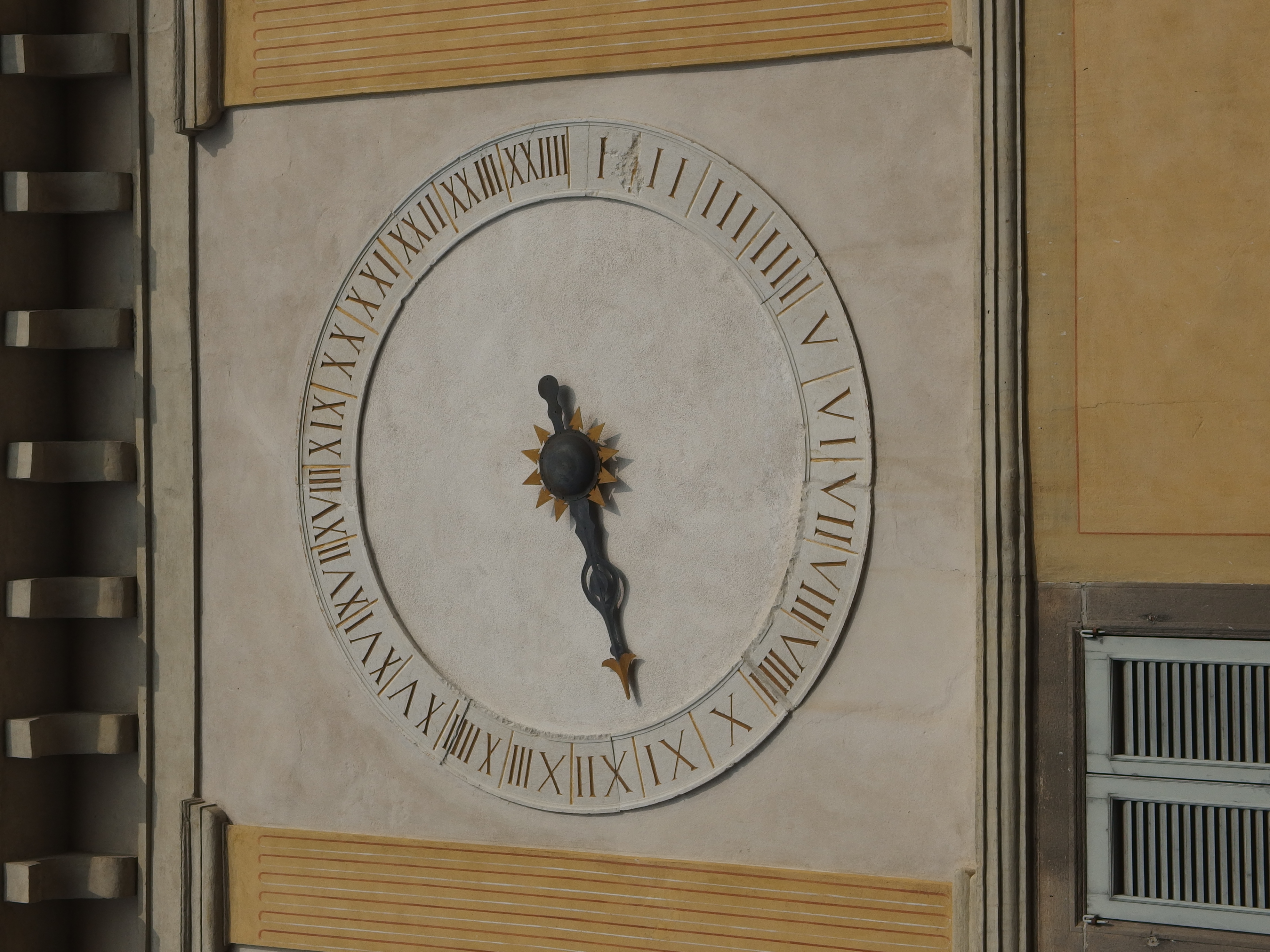
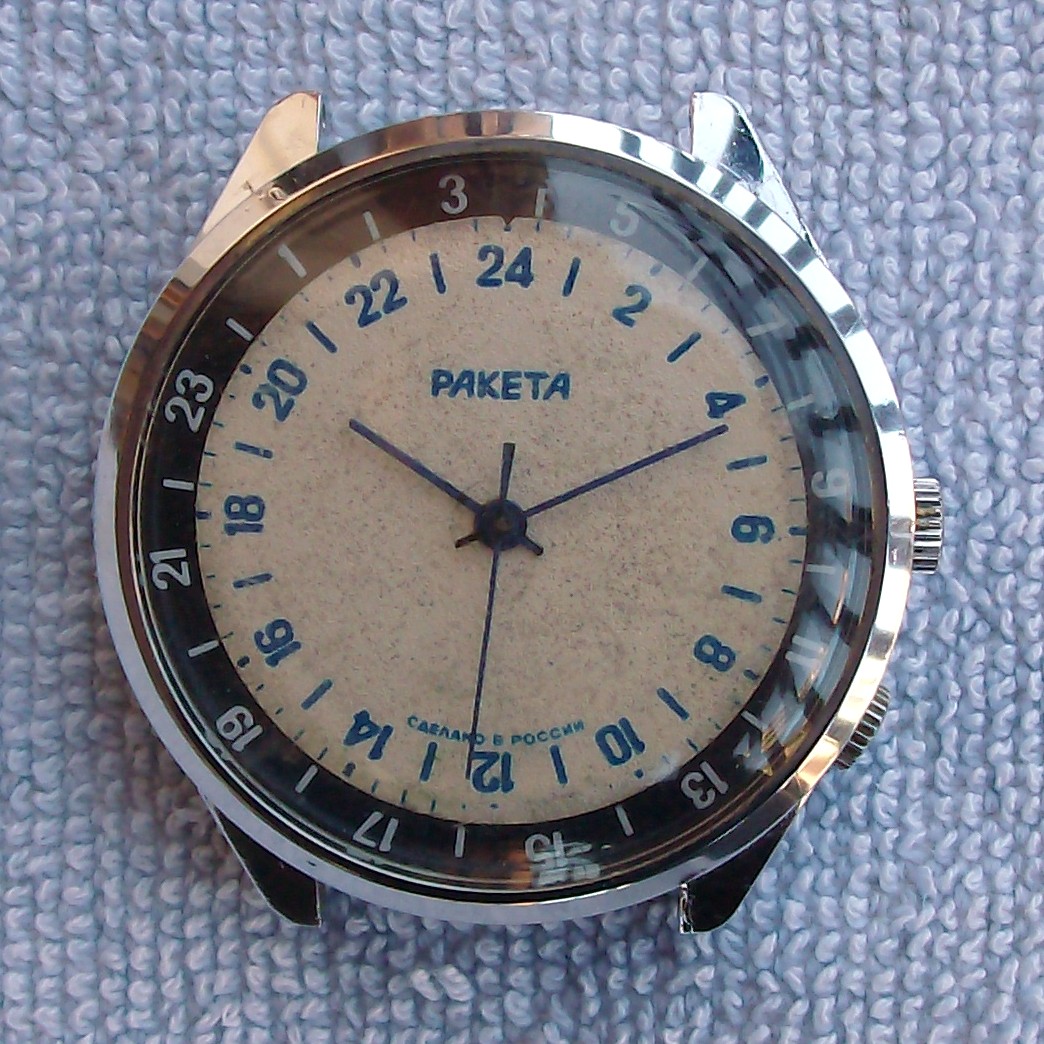

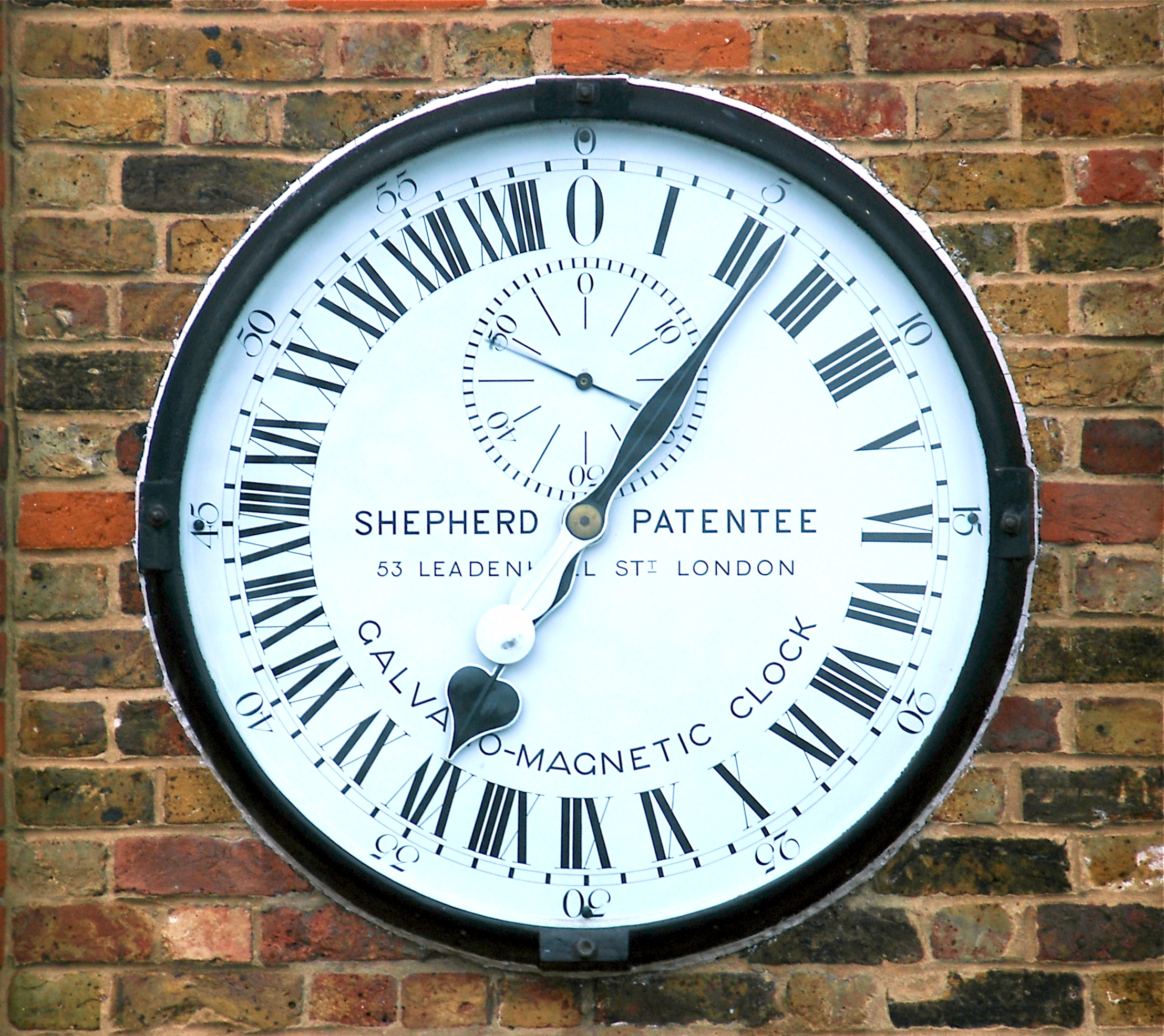


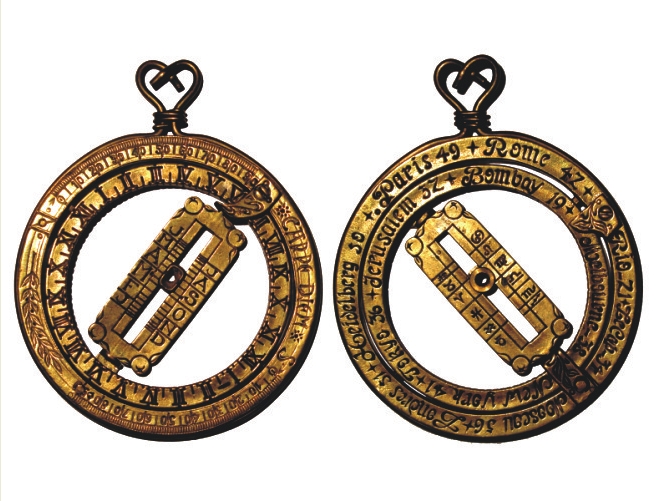 Sundials use some or all of the 24-hour dial, because they show the position of the sun in the sky. Sometimes, for aesthetic rather than practical reasons, all the 24 hour marks are shown.
Medieval clocks often used the 24-hour analog dial, influenced by the widespread example of the astrolabe.Geared to the Stars: The Evolution of Planetariums, Orreries, and Astronomical Clocks, Henry C King, University of Toronto Press; (1978) In Northern Europe, the double-XII system was preferred: two sets of the Roman numerals I to XII were used, one on the left side for the night and morning hours, and another set on the right side of the dial to represent the afternoon and evening hours. In Italy, the numbers from 1 to 24 (I to XXIV in Roman numerals) were used, leading to the widespread use of the 24-hour system in that country. On Italian clocks, though, the I was often shown at the right side of the dial, rather than the top. This probably reflects the influence of the Italian timekeeping system, which started counting the hours of the day at sunset or twilight.
In northern Europe, the double XII system was gradually superseded during the 14th and 15th centuries by the single XII (12-hour system), leading to the widespread adoption of the 12-hour dial for popular use. The 24-hour analog dial continued to be used, but primarily by technicians, astronomers, scientists, and clockmakers.
Sundials use some or all of the 24-hour dial, because they show the position of the sun in the sky. Sometimes, for aesthetic rather than practical reasons, all the 24 hour marks are shown.
Medieval clocks often used the 24-hour analog dial, influenced by the widespread example of the astrolabe.Geared to the Stars: The Evolution of Planetariums, Orreries, and Astronomical Clocks, Henry C King, University of Toronto Press; (1978) In Northern Europe, the double-XII system was preferred: two sets of the Roman numerals I to XII were used, one on the left side for the night and morning hours, and another set on the right side of the dial to represent the afternoon and evening hours. In Italy, the numbers from 1 to 24 (I to XXIV in Roman numerals) were used, leading to the widespread use of the 24-hour system in that country. On Italian clocks, though, the I was often shown at the right side of the dial, rather than the top. This probably reflects the influence of the Italian timekeeping system, which started counting the hours of the day at sunset or twilight.
In northern Europe, the double XII system was gradually superseded during the 14th and 15th centuries by the single XII (12-hour system), leading to the widespread adoption of the 12-hour dial for popular use. The 24-hour analog dial continued to be used, but primarily by technicians, astronomers, scientists, and clockmakers.
Image:Glycine_Airman_I.jpg, Glycine Airman
Image:Swatch24hourwatch.jpg, Swatch 24-hour watch
Image:Hamilton.jpg, 24-hour chronograph by Hamilton
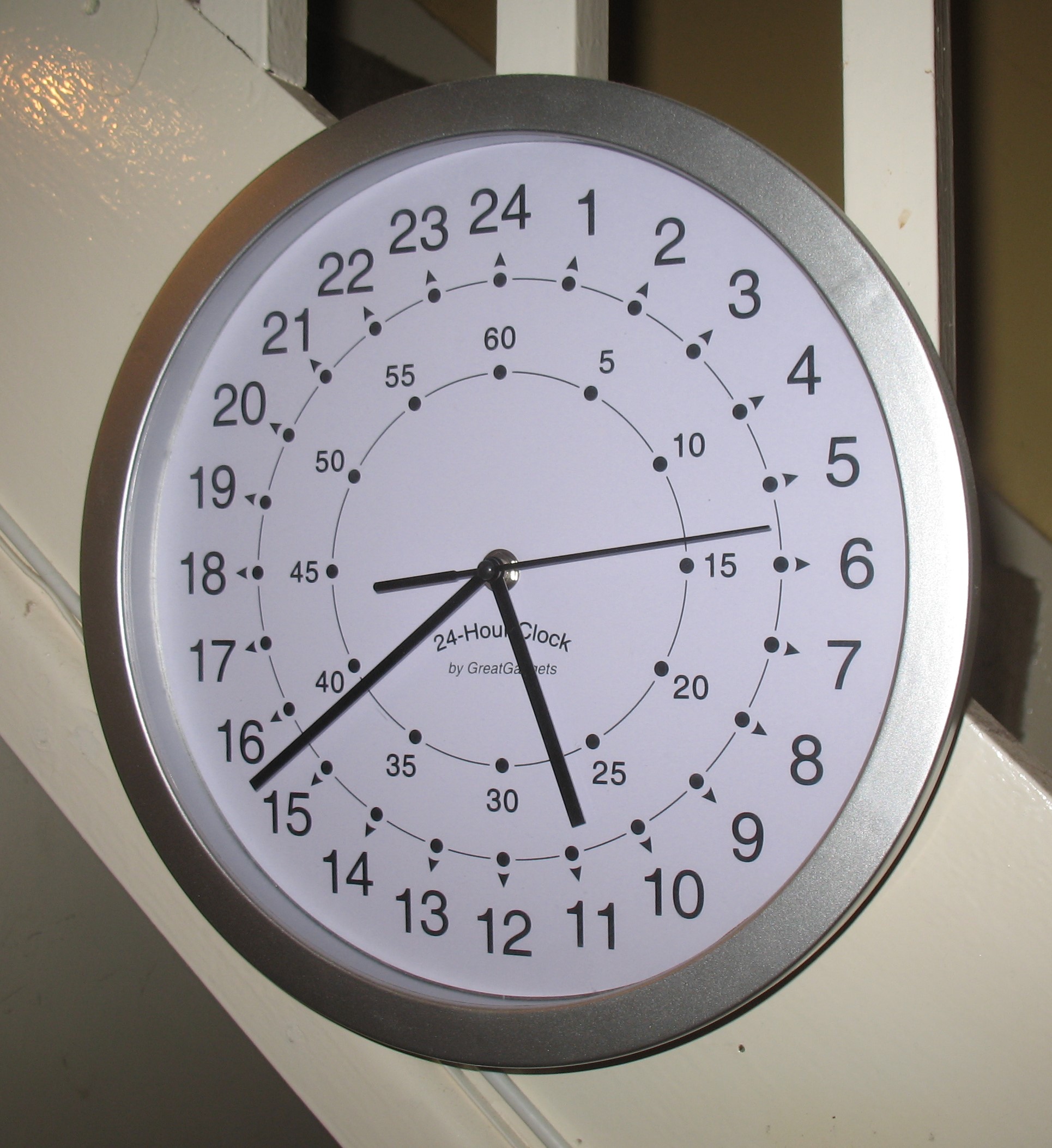
 The major variation in the design of 24-hour analog dials is the location of midnight and noon. Although always opposite each other, 180° apart, noon is sometimes at the top, sometimes at the bottom. A few rare variants place noon and midnight at the right and left sides. There is no ambiguity if the 24-hour numbering is used.
In the United States, the government and military commonly use 24-hour clocks having noon at the bottom; the variant with noon at the top is far less common.
The major variation in the design of 24-hour analog dials is the location of midnight and noon. Although always opposite each other, 180° apart, noon is sometimes at the top, sometimes at the bottom. A few rare variants place noon and midnight at the right and left sides. There is no ambiguity if the 24-hour numbering is used.
In the United States, the government and military commonly use 24-hour clocks having noon at the bottom; the variant with noon at the top is far less common.
 A 24-hour watch is a type of
A 24-hour watch is a type of
 A common use for the 24-hour analog method of representing time is for showing the way the time of day depends on one's location. A globe, map, or disk can be used.
A common use for the 24-hour analog method of representing time is for showing the way the time of day depends on one's location. A globe, map, or disk can be used.





Clock
A clock or a timepiece is a device used to measure and indicate time. The clock is one of the oldest human inventions, meeting the need to measure intervals of time shorter than the natural units such as the day, the lunar month and t ...
s and watches
A watch is a portable timepiece intended to be carried or worn by a person. It is designed to keep a consistent movement despite the motions caused by the person's activities. A wristwatch is designed to be worn around the wrist, attached b ...
with a 24-hour analog dial have an hour hand that makes one complete revolution, 360°, in a day (24 hours per revolution). The more familiar 12-hour analog dial has an hour hand that makes two complete revolutions in a day (12 hours per revolution).
Twenty-four-hour analog clocks and watches are used today by logistics workers, fire fighters, police officers, paramedics, nurses, pilots, scientists, and the military, and are sometimes preferred because of the unambiguous representation of a whole day at a time. Note that this definition refers to the use of a complete circular dial to represent a 24-hour day. Using the numbers from 0 to 23 (or 1 to 24) to mark the day is the '' 24-hour clock system''.
Sundials
A sundial is a horological device that tells the time of day (referred to as civil time in modern usage) when direct sunlight shines by the apparent position of the Sun in the sky. In the narrowest sense of the word, it consists of a flat ...
use 24-hour analog dials—the shadow traces a path that repeats approximately once per day.
Many sundials are marked with the double-XII or double-12 system, in which the numbers I to XII (or 1 to 12) are used twice, once for the morning hours, and once for the afternoon and evening hours. So VI (or 6) appears twice on many dials, once near sunrise and once near sunset.
Modern 24-hour analog dials—other than sundials—are almost always marked with 24 numbers or hour marks around the edge, using the 24-hour clock system. These dials do not need to indicate AM or PM.
History
The ancient Egyptians divided the day into 24 hours. There are diagrams of circles divided into 24 sections in the astronomical ceiling in the tomb ofSenemut
Senenmut ( egy, sn-n-mwt, sometimes spelled Senmut, Senemut, or Senmout) was an 18th Dynasty ancient Egyptian architect and government official. His name translates literally as "mother's brother."
Family
Senenmut was of low commoner birth, ...
.
 Sundials use some or all of the 24-hour dial, because they show the position of the sun in the sky. Sometimes, for aesthetic rather than practical reasons, all the 24 hour marks are shown.
Medieval clocks often used the 24-hour analog dial, influenced by the widespread example of the astrolabe.Geared to the Stars: The Evolution of Planetariums, Orreries, and Astronomical Clocks, Henry C King, University of Toronto Press; (1978) In Northern Europe, the double-XII system was preferred: two sets of the Roman numerals I to XII were used, one on the left side for the night and morning hours, and another set on the right side of the dial to represent the afternoon and evening hours. In Italy, the numbers from 1 to 24 (I to XXIV in Roman numerals) were used, leading to the widespread use of the 24-hour system in that country. On Italian clocks, though, the I was often shown at the right side of the dial, rather than the top. This probably reflects the influence of the Italian timekeeping system, which started counting the hours of the day at sunset or twilight.
In northern Europe, the double XII system was gradually superseded during the 14th and 15th centuries by the single XII (12-hour system), leading to the widespread adoption of the 12-hour dial for popular use. The 24-hour analog dial continued to be used, but primarily by technicians, astronomers, scientists, and clockmakers.
Sundials use some or all of the 24-hour dial, because they show the position of the sun in the sky. Sometimes, for aesthetic rather than practical reasons, all the 24 hour marks are shown.
Medieval clocks often used the 24-hour analog dial, influenced by the widespread example of the astrolabe.Geared to the Stars: The Evolution of Planetariums, Orreries, and Astronomical Clocks, Henry C King, University of Toronto Press; (1978) In Northern Europe, the double-XII system was preferred: two sets of the Roman numerals I to XII were used, one on the left side for the night and morning hours, and another set on the right side of the dial to represent the afternoon and evening hours. In Italy, the numbers from 1 to 24 (I to XXIV in Roman numerals) were used, leading to the widespread use of the 24-hour system in that country. On Italian clocks, though, the I was often shown at the right side of the dial, rather than the top. This probably reflects the influence of the Italian timekeeping system, which started counting the hours of the day at sunset or twilight.
In northern Europe, the double XII system was gradually superseded during the 14th and 15th centuries by the single XII (12-hour system), leading to the widespread adoption of the 12-hour dial for popular use. The 24-hour analog dial continued to be used, but primarily by technicians, astronomers, scientists, and clockmakers. John Harrison
John Harrison ( – 24 March 1776) was a self-educated English carpenter and clockmaker who invented the marine chronometer, a long-sought-after device for solving the problem of calculating longitude while at sea.
Harrison's solution revol ...
, Thomas Tompion
Thomas Tompion, FRS (1639–1713) was an English clockmaker, watchmaker and mechanician who is still regarded to this day as the "Father of English Clockmaking". Tompion's work includes some of the most historic and important clocks and watc ...
, and Mudge built a number of clocks with 24-hour analog dials, particularly when building astronomical and nautical instruments. 24-hour dials were also used on sidereal clocks.
The famous Big Ben clock in London has a 24-hour dial as part of the mechanism, although it is not visible from the outside.
In the 20th century, the 24-hour analog dial was adopted by radio amateurs, pilots, submariners, and for military use.
Today
24-hour analog watches and clocks are still being manufactured today, and are sought after by collectors and enthusiasts. Manufacturers who make 24-hour analog watches includeGlycine
Glycine (symbol Gly or G; ) is an amino acid that has a single hydrogen atom as its side chain. It is the simplest stable amino acid ( carbamic acid is unstable), with the chemical formula NH2‐ CH2‐ COOH. Glycine is one of the proteinog ...
, Raketa
Raketa ( rus, Ракета, p=rɐˈkʲɛtə, "Rocket") wristwatches, have been manufactured since 1961 by the Petrodvorets Watch Factory in Saint Petersburg. The Petrodvorets Watch Factory is Russia's oldest factory, founded by Peter the Great ...
, Vostok Vostok refers to east in Russian but may also refer to:
Spaceflight
* Vostok programme, Soviet human spaceflight project
* Vostok (spacecraft), a type of spacecraft built by the Soviet Union
* Vostok (rocket family), family of rockets derived from ...
, Fortis, Poljot
Poljot (russian: Полёт, literally meaning "flight"), is a brand of Soviet/Russian wristwatches, produced since 1964 by the First Moscow Watch Factory (russian: Первый Московский Часовой Завод, ПМЧЗ, ''Perviy M ...
, Swatch
Swatch is a Swiss watchmaker founded in 1983 by Ernst Thomke, Elmar Mock, and Jacques Müller. It is a subsidiary of The Swatch Group. The Swatch product line was developed as a response to the "quartz crisis" of the 1970s and 1980s, in which ...
, and many others.
Design

 The major variation in the design of 24-hour analog dials is the location of midnight and noon. Although always opposite each other, 180° apart, noon is sometimes at the top, sometimes at the bottom. A few rare variants place noon and midnight at the right and left sides. There is no ambiguity if the 24-hour numbering is used.
In the United States, the government and military commonly use 24-hour clocks having noon at the bottom; the variant with noon at the top is far less common.
The major variation in the design of 24-hour analog dials is the location of midnight and noon. Although always opposite each other, 180° apart, noon is sometimes at the top, sometimes at the bottom. A few rare variants place noon and midnight at the right and left sides. There is no ambiguity if the 24-hour numbering is used.
In the United States, the government and military commonly use 24-hour clocks having noon at the bottom; the variant with noon at the top is far less common.
Watches
 A 24-hour watch is a type of
A 24-hour watch is a type of watch
A watch is a portable timepiece intended to be carried or worn by a person. It is designed to keep a consistent movement despite the motions caused by the person's activities. A wristwatch is designed to be worn around the wrist, attached b ...
with an hour hand
A clock face is the part of an analog clock (or watch) that displays time through the use of a flat dial with reference marks, and revolving pointers turning on concentric shafts at the center, called hands. In its most basic, globally recogni ...
that completes a revolution every 24 hours.
The face may be arranged in either of two ways: with noon at the top and midnight at the bottom (similar to how one might observe the passage of the Sun over their time zone whilst facing south), or else rotated 180° with midnight at the top and noon at the bottom (as pictured).
Multiple time zones
Time is the continued sequence of existence and event (philosophy), events that occurs in an apparently irreversible process, irreversible succession from the past, through the present, into the future. It is a component quantity of various me ...
can be displayed by having multiple hour hands or a rotating bezel. The bezel is a ring around the outside of the watch's face. When it is used, the top of the watch always represents midnight (or noon) GMT
Greenwich Mean Time (GMT) is the mean solar time at the Royal Observatory in Greenwich, London, counted from midnight. At different times in the past, it has been calculated in different ways, including being calculated from noon; as a cons ...
. The bezel, which also has hour markings, is then rotated so that its numbering represents local time. So, a pilot always has GMT time available for talking to air traffic control and, when they land, only has to rotate the bezel to "set" the watch to their new local time. Glycine
Glycine (symbol Gly or G; ) is an amino acid that has a single hydrogen atom as its side chain. It is the simplest stable amino acid ( carbamic acid is unstable), with the chemical formula NH2‐ CH2‐ COOH. Glycine is one of the proteinog ...
was the first to feature a 24-hour rotating bezel in 1953 with the Airman No.1 Pilot watch. The design became widely known when Rolex
Rolex SA () is a British-founded Swiss watch designer and manufacturer based in Geneva, Switzerland. Founded in 1905 as ''Wilsdorf and Davis'' by Hans Wilsdorf and Alfred Davis in London, the company registered ''Rolex'' as the brand name of ...
designed the Rolex GMT Master for Pan-Am
Pan American World Airways, originally founded as Pan American Airways and commonly known as Pan Am, was an American airline that was the principal and largest international air carrier and unofficial overseas flag carrier of the United State ...
Pilots in 1954.
A 24-hour watch with a compass card dial can be used to determine direction when set to local noon and used in conjunction with the sun.
Many (but not all) digital watches can be set to show the time in 24-hour format.
Notable 24-hour watch brands
* Akerfalk (Swedish) * Gallet (Swiss) *Glycine
Glycine (symbol Gly or G; ) is an amino acid that has a single hydrogen atom as its side chain. It is the simplest stable amino acid ( carbamic acid is unstable), with the chemical formula NH2‐ CH2‐ COOH. Glycine is one of the proteinog ...
(Swiss)
* Oris /(Swiss)
*Poljot
Poljot (russian: Полёт, literally meaning "flight"), is a brand of Soviet/Russian wristwatches, produced since 1964 by the First Moscow Watch Factory (russian: Первый Московский Часовой Завод, ПМЧЗ, ''Perviy M ...
(Russian)
*Raketa
Raketa ( rus, Ракета, p=rɐˈkʲɛtə, "Rocket") wristwatches, have been manufactured since 1961 by the Petrodvorets Watch Factory in Saint Petersburg. The Petrodvorets Watch Factory is Russia's oldest factory, founded by Peter the Great ...
(USSR Russian)
*Rolex
Rolex SA () is a British-founded Swiss watch designer and manufacturer based in Geneva, Switzerland. Founded in 1905 as ''Wilsdorf and Davis'' by Hans Wilsdorf and Alfred Davis in London, the company registered ''Rolex'' as the brand name of ...
(Swiss)
*Seiko
, commonly known as Seiko ( , ), is a Japanese maker of watches, clocks, electronic devices, semiconductors, jewelry, and optical products. Founded in 1881 by Kintarō Hattori in Tokyo, Seiko introduced one of the first quartz watches and the ...
(Japan)
* Forté (USA)
* Slow watch (Swiss)
World time
 A common use for the 24-hour analog method of representing time is for showing the way the time of day depends on one's location. A globe, map, or disk can be used.
A common use for the 24-hour analog method of representing time is for showing the way the time of day depends on one's location. A globe, map, or disk can be used.

In fiction
George Orwell uses the 12-hour and 24-hour dials to symbolize the old and new worlds in his novel ''Nineteen Eighty-Four
''Nineteen Eighty-Four'' (also stylised as ''1984'') is a dystopian social science fiction novel and cautionary tale written by the English writer George Orwell. It was published on 8 June 1949 by Secker & Warburg as Orwell's ninth and fina ...
''. The 12-hour dial is a relic of pre-revolutionary society, used to represent the desirable past; the 24-hour dial and time system is the compulsory standard imposed by the Party, and represents both conformity and the undesirable nature of the new world. This theme is famously set in the opening line:
:It was a bright cold day in April, and the clocks were striking thirteen.
In the 1927 film ''Metropolis
A metropolis () is a large city or conurbation which is a significant economic, political, and cultural center for a country or region, and an important hub for regional or international connections, commerce, and communications.
A big ci ...
'', the opening scene shows both a 24-hour analog clock and a 10-hour (decimal) analog clock, one above the other. Both are used to convey the impression of an alien and highly efficient society.
In Jules Verne's science fiction masterpiece ''20,000 Leagues Under the Sea
''Twenty Thousand Leagues Under the Seas'' (french: Vingt mille lieues sous les mers) is a classic science fiction adventure novel by French writer Jules Verne.
The novel was originally serialized from March 1869 through June 1870 in Pierre-J ...
'', Captain Nemo remarks that the clocks in the Nautilus use a 24-hour dial: "Now, look at that clock: it's electric, it runs with an accuracy rivaling the finest chronometers. I've had it divided into twenty–four hours like Italian clocks, since neither day nor night, sun nor moon, exist for me, but only this artificial light that I import into the depths of the seas! See, right now it's ten o'clock in the morning."
See also
* 24-hour clock * Direction finding watch * Sector clockReferences
Further reading
* * {{DEFAULTSORT:24-Hour Analog Dial 24-hour clocks and watches